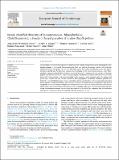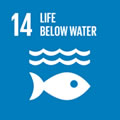Por favor, use este identificador para citar o enlazar a este item:
http://hdl.handle.net/10261/347484COMPARTIR / EXPORTAR:
 SHARE SHARE
 CORE
BASE CORE
BASE
|
|
| Visualizar otros formatos: MARC | Dublin Core | RDF | ORE | MODS | METS | DIDL | DATACITE | |

| Título: | Newly identified diversity of Dinomycetaceae (Rhizophydiales, Chytridiomycota), a family of fungal parasites of marine dinoflagellates |
Autor: | Fernández Valero, Alan D. CSIC ORCID ; Karpov, Sergey A.; Sampedro, Nagore CSIC ORCID ; Gordi, Jordina; Timoneda Solé, Natàlia CSIC ORCID CVN ; Garcés, Esther CSIC ORCID CVN ; Reñé, Albert CSIC ORCID | Palabras clave: | Chytridiomycota Coastal ecosystems Dinoflagellate Fungi Molecular phylogeny Ultrastructure Fungal parasites |
Fecha de publicación: | abr-2024 | Editor: | Elsevier | Citación: | European Journal of Protistology 93: 126053 (2024) | Resumen: | We identified two new parasite species of Chytridiomycota isolated during blooms of the dinoflagellate Alexandrium minutum in the coastal Mediterranean Sea. Light and electron microscopy together with molecular characterization of the nuclear 18S, ITS, and 28S rDNA regions led to their identification as two new species, Dinomyces gilberthii and Paradinomyces evelyniae, both belonging to the family Dinomycetaceae, order Rhizophydiales. Dinomyces gilberthii differs from the previously described D. arenysensis by the presence of discharge papillae and the development of a drop-shaped sporangium. Paradinomyces evelyniae differs from the previously described P. triforaminorum by the prominent lipid globule present in early sporangia and by the pointed end producing a rhizoid. The two chytrids differed in their geographical distribution. Dinomyces gilberthii was detected in several Mediterranean habitats, including harbours and beaches, and was particularly prevalent during summer dinoflagellate blooms. Its widespread occurrence in coastal ecosystems suggested a high level of adaptability to this environment. Paradinomyces evelyniae had a more restricted distribution in the coastal-marine environment, occurring in harbour sediments and only occasionally in the water column during winter and early spring. Paradinomyces evelyniae has previously been detected in the Baltic Sea, suggesting that its distribution encompasses contrasting coastal environments, although its presence is rare | Descripción: | 12 pages, 5 figures, 2 tables, supplementary data https://doi.org/10.1016/j.ejop.2024.126053.-- Data availability statement: Molecular sequences generated in this study are publicly available in GenBank. Phylogenetic alignments analysed in the present study are available from the corresponding author upon request | Versión del editor: | https://doi.org/10.1016/j.ejop.2024.126053 | URI: | http://hdl.handle.net/10261/347484 | DOI: | 10.1016/j.ejop.2024.126053 | ISSN: | 0932-4739 |
| Aparece en las colecciones: | (ICM) Artículos |
Ficheros en este ítem:
| Fichero | Descripción | Tamaño | Formato | |
|---|---|---|---|---|
| Fernandez_Valero_et_al_2024.pdf | 16,36 MB | Adobe PDF |  Visualizar/Abrir | |
| Fernandez_Valero_et_al_2024_suppl_1.mp4 | 5,06 MB | MP4 | Visualizar/Abrir | |
| Fernandez_Valero_et_al_2024_suppl_2.mp4 | 3,17 MB | MP4 | Visualizar/Abrir | |
| Fernandez_Valero_et_al_2024_suppl_3.docx | 14,33 kB | Microsoft Word XML | Visualizar/Abrir |
CORE Recommender
Page view(s)
19
checked on 27-abr-2024
Download(s)
12
checked on 27-abr-2024
Google ScholarTM
Check
Altmetric
Altmetric
Este item está licenciado bajo una Licencia Creative Commons



